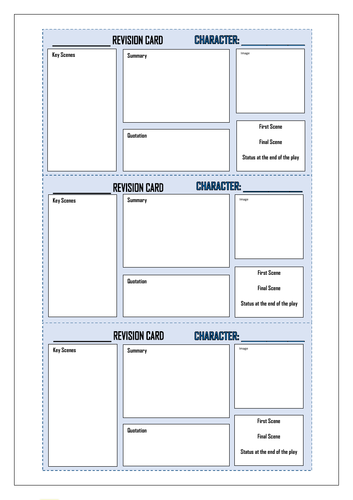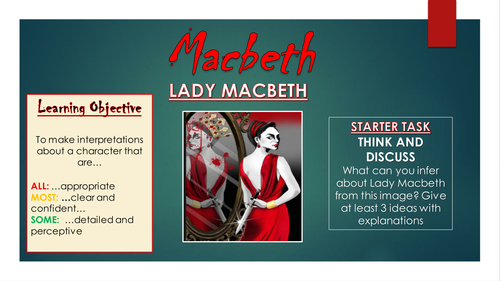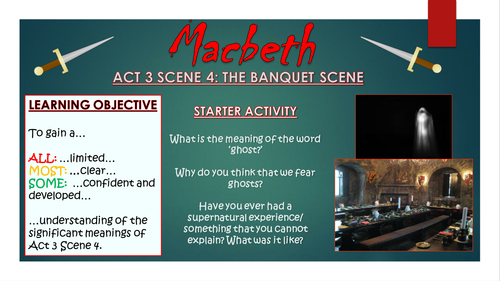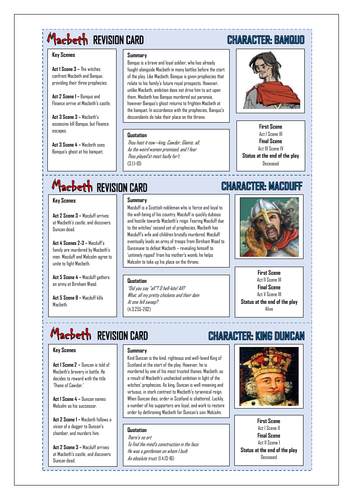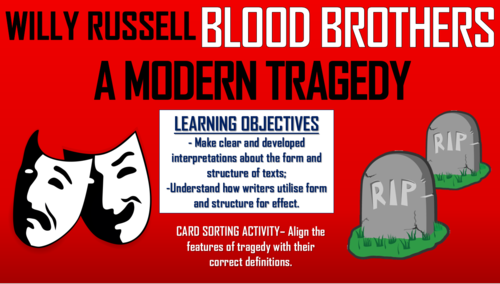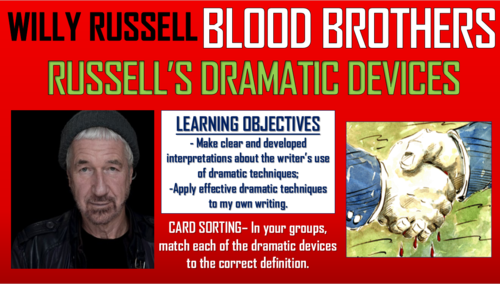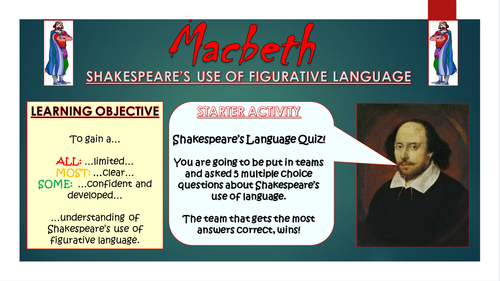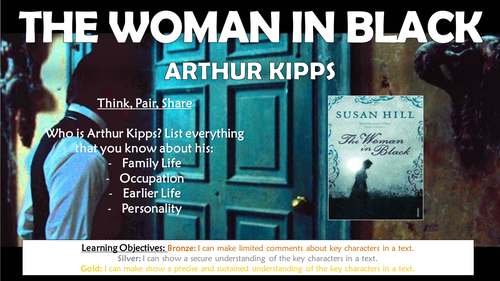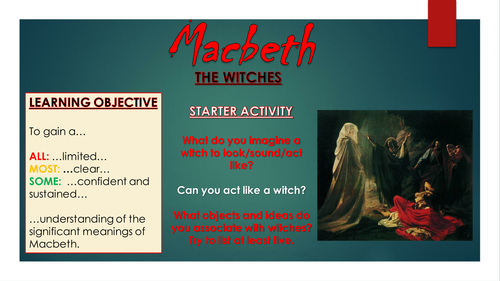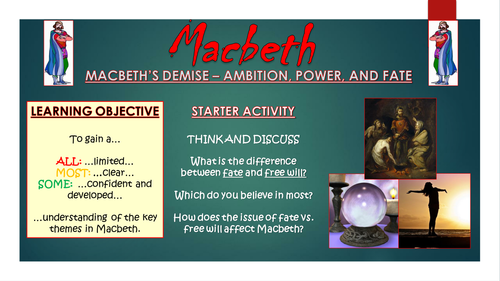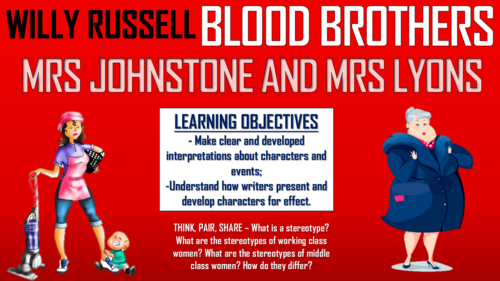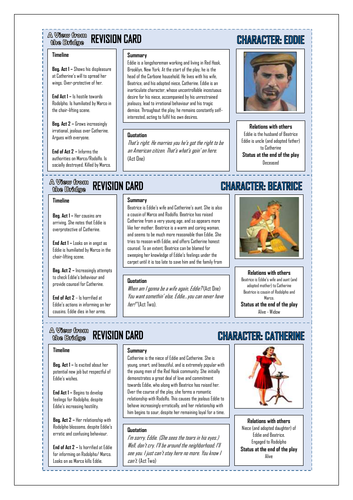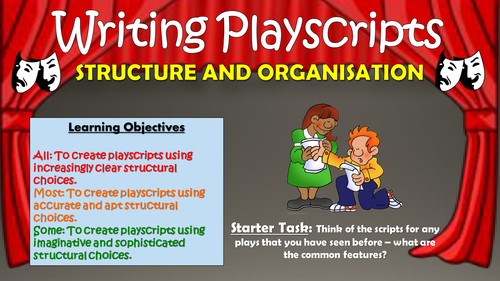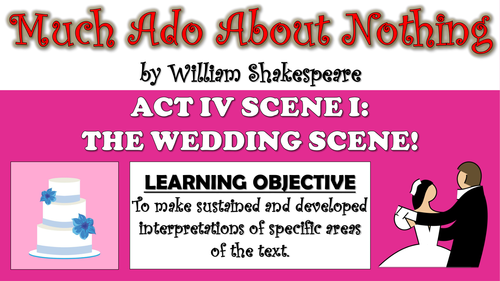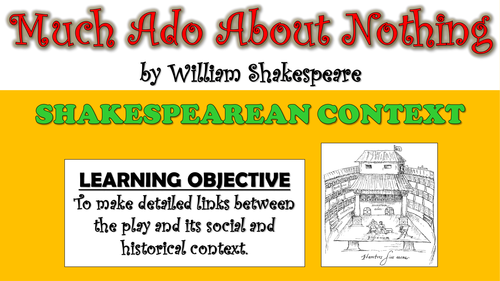
3k+Uploads
1845k+Views
2197k+Downloads
Drama

English Revision Cards Blank Templates - for Plays
These colouful and well-structured card templates are designed to aid student revision of key topic areas. They can be filled in by either students or teachers, and then used by incorporating them into revision games, as essay writing aids, or as home revision aids. They are provided as both PDFs (to prevent formatting issues between computers) and as Word documents (for easy editing). They simply need to be cut out (if printed on card) and laminated (if printed on paper). This particular pack is intended for the revision of plays, and includes cards to aid the revision of:
Characters
Context
Devices
Scenes
Themes
I’ve also included an model example of how to fill the cards out, using characters from Macbeth.
For any questions or comments, please contact TandLGuru@yahoo.co.uk - Many thanks!

Macbeth: Act 2 Scene 2 - The Murder of King Duncan!
This lesson aims to improve students’ understanding of one of the key scenes in William Shakespeare’s Macbeth – Act II Scene II. In particular, they learn to make insightful interpretations about Shakespeare’s use of symbolism, and are enabled to understand how this would have affected Shakespearean audiences.
The lesson utilises a range of tasks, that require students to be visual and interactive learners. It follows this learning journey:
- Defining the key term 'symbolism' and establishing its importance as a literary technique;
- Understanding the different objects that were used as symbols in Shakesperean times through a multiple choice team game;
- Reading and interpreting Act 2 Scene 2, and establishing how symbolism is utilised throughout;
- Summarising the events of the scene;
- Analysing Shakespeare's intentions in using literary techniques, and considering the audience reactions to them;
- Peer/self evaluating the learning in the lesson.
Included in this resource pack are:
- A well-presented, thorough, and informative, whole-lesson PowerPoint presentation;
- Resources for the reading and interpreting activity - full scene transcript with space for notes;
- A template to help scaffold the main task, complete with P.E.E instructions;
- A comprehensive teacher guidance form/lesson plan to assist delivery.
All images in this resource are licensed for commercial use, and are cited on the final slide of the lesson presentation.

Macbeth: Lady Macbeth
This engaging and interesting lesson aims to improve students’ understanding of one of the key characters in William Shakespeare’s Macbeth: Lady Macbeth. In particular, they learn to make insightful interpretations about the character, and are enabled to draw links between Lady Macbeth and their knowledge of women in Shakespearean times.
The lesson utilises a range of tasks, that require students to be visual and interactive learners. It follows this learning journey:
- Inferring key information about the character of Lady Macbeth from picture clues;
- Identifying and ordering the key events in the text in which Lady Macbeth is involved;
- Understanding her role in the rise and downfall of Macbeth;
- Comparing and contrasting between her character and the expected role of women at the time the play was written;
- Analysing Shakespeare's development of Lady Macbeth as a key character throughout the text;
- Evaluating the learning in the lesson.
Included in this resource pack are:
- A well-presented, thorough, and informative, whole-lesson PowerPoint presentation;
- Resources for the sequencing activity, detailing Lady Macbeth's numerous actions throughout the play;
- A template to help scaffold the main task, complete with P.E.E instructions;
- A comprehensive teacher guidance form/lesson plan to assist delivery.
All images in this resource are licensed for commercial use, and are cited on the final slide of the lesson presentation.

Macbeth: Act 3 Scene 4 - The Ghost (Banquet) Scene!
This lesson aims to improve students’ understanding of one of the key scenes in William Shakespeare’s Macbeth – Act III Scene IV. In particular, they learn to make insightful interpretations about the changing nature of Macbeth’s tone throughout the scene, and are enabled to understand how this would have affected Shakespearean audiences.
The lesson utilises a range of tasks, that require students to be visual and interactive learners. It follows this learning journey:
- Defining the key term 'tone' and establishing its importance as a literary technique;
- Understanding how tone is used to depict mood and attitude across a range of fiction;
- Reading and interpreting Act 3 Scene 4, and establishing how Macbeth's tone alters throughout;
- Reflecting upon why this may/ what effect this may have had on audiences at the time;
- Summarising the events of the scene;
- Analysing Shakespeare's intentions in sharply altering Macbeth's tone throughout;
- Peer/self evaluating the learning in the lesson.
Included in this resource pack are:
- A well-presented, thorough, and informative, whole-lesson PowerPoint presentation;
- Resources for the reading and interpreting activity - full scene transcript with space for notes;
- A template to help scaffold the main task, complete with P.E.E instructions;
- Cards for the card sorting group activity
- A comprehensive teacher guidance form/lesson plan to assist delivery.
All images in this resource are licensed for commercial use, and are cited on the final slide of the lesson presentation.

Macbeth Revision Cards!
These colourful, comprehensive, and well-structured revision cards have been creatively designed for students securing their understanding of William Shakespeare’s tragedy ‘Macbeth.’ Each card is visually-appealing and highly-detailed, covering aspects of each feature including a full summary, cited quotations from the play, definitions/ examples, and a consideration of audience reactions. They are tried and tested, with teachers incorporating them in revision games, using them as essay writing aids, or utilising them as home revision aids. They are provided as both PDFs (to prevent formatting issues between computers) and as Word documents (for easy editing).
The revision cards included in this pack are:
Characters - Macbeth, Lady Macbeth, The Witches, Banquo, King Duncan, Macduff;
Context - William Shakespeare, James I and Divine Right, Witches and the Supernatural;
Devices - Dramatic Irony, Soliloquies and Asides, Dramatic Tension;
Scenes - Act 1 Scene 3 (Witches’ prophecies), Act 3 Scene 4 (Banquet/ Banquo’s ghost), Act 5 Scene 1 (Lady Macbeth sleepwalking);
Themes - Unchecked Ambition, Madness, Fate and the Supernatural.
For any questions or comments, please contact TandLGuru@yahoo.co.uk - Many thanks!

Blood Brothers - Mickey and Edward!
This engaging and interesting lesson enables students to make clear and developed interpretations of the characters of Mickey and Edward in Willy Russell’s Blood Brothers. In particular, students infer and interpret key information about the characters from their introductions into the play, before tracking how their characters develop through close analysis of their key actions and quotations.
The lesson utilises a range of tasks, that require students to be both independent and collaborative learners. It follows this learning journey:
Considering the idea of money ‘buying happiness’ and applying this concept to characters in the play;
Engaging with the opening to the play and interpreting how Mickey and Edward are presented;
Tracking how the characters are developed throughout the play, through engagement with their key actions and quotations;
Creating character profiles which demonstrate their understanding of Mickey and Edward’s introduction and development throughout the play;
Self-evaluating their learning in the lesson.
Included in this resource pack are:
A well-presented, thorough, and informative, whole-lesson PowerPoint presentation;
Appropriate extracts from the play;
A template morale graph to enable students to track the development of characters;
Character profile templates to help scaffold the main task, complete with quotes from the text;
A comprehensive teacher guidance form/lesson plan to assist delivery.
Resources are provided in both Word (for easy editing)and PDF (to prevent formatting issues between computers).
All images in this resource are licensed for commercial use, and are cited on the final slide of the lesson presentation.

Blood Brothers - A Modern Tragedy
This engaging and interesting lesson enables students to make clear and developed interpretations regarding the form and structure of Willy Russell’s Blood Brothers. In particular, students learn about the key features of tragedies, identify these in the play, and analyse their effectiveness, considering Russell’s intentions.
The lesson utilises a range of tasks, that require students to be both independent and collaborative learners. It follows this learning journey:
Defining and exemplifying each of the features of tragedies;
Inspecting the play, identifying and analysing Russell’s use of the features of tragedies throughout;
Understanding the writer’s intentions and the anticipated audience reactions through some of the features of tragedies;
Creating a mind map demonstrating the effectiveness of the features of tragedy upon the audience;
Applying their understanding of the features of tragedy in the play to a storyboarding activity;
Self-evaluating their learning in the lesson.
Included in this resource pack are:
A well-presented, thorough, and informative, whole-lesson PowerPoint presentation;
Features of tragedy cards for the card-sorting activity;
‘Text Inspector’ worksheet for the identification task;
Template for the storyboarding activity;
A comprehensive teacher guidance form/lesson plan to assist delivery.
Resources are provided in both Word (for easy editing - find in the zip file)and PDF (to prevent formatting issues between computers).
All images in this resource are licensed for commercial use, and are cited on the final slide of the lesson presentation.

Blood Brothers - Russell's Dramatic Devices!
This engaging and interesting lesson enables students to make clear and developed interpretations regarding Willy Russell’s use of dramatic devices throughout Blood Brothers. In particular, students define eight advanced dramatic techniques used by writers, identify these in selected extracts from the play, and analyse their effectiveness. They then apply their new understanding to their own dramatic scene.
The lesson utilises a range of tasks, that require students to be both independent and collaborative learners. It follows this learning journey:
Defining and exemplifying each of the dramatic devices;
Reading and comprehending extracts from the play, identifying and analysing Russell’s use of dramatic devices throughout;
Understanding the writer’s intentions and the anticipated audience reactions through some of the dramatic devices;
Creating revision cards demonstrating full understanding of the dramatic devices: definitions, examples, effects;
Applying their understanding of dramatic devices to their own imaginative and emotional playscript scenes;
Self-evaluating their learning in the lesson.
Included in this resource pack are:
A well-presented, thorough, and informative, whole-lesson PowerPoint presentation;
Appropriate extracts from the play;
Dramatic devices cards for the card-sorting activity;
Templates for creating the revision cards;
A comprehensive teacher guidance form/lesson plan to assist delivery.
Resources are provided in both Word (for easy editing)and PDF (to prevent formatting issues between computers).
All images in this resource are licensed for commercial use, and are cited on the final slide of the lesson presentation.

Macbeth: Shakespeare's Figurative Language!
This interesting and stimulating lesson aims to improve students’ understanding of Shakespeare’s use of figurative language in Macbeth, focusing particularly on similes, metaphors, personification, hyperbole, and euphemisms. Students learn to analyse the intended effect of these devices through a close-reading and interpretation of Act 5 Scene 1: The sleepwalking scene involving Lady Macbeth.
The lesson utilises a range of tasks, that require students to be visual and interactive learners. It follows this learning journey:
- Defining the key term 'figurative language' and establishing its importance as a literary technique;
- Defining and exemplifying each of the key terms 'simile, metaphor, personification, hyperbole, and euphemisms through collaborative group opportunities;
- Understanding how and why figurative language is used to add depth to writers' ideas;
- Reading and interpreting Act 5 Scene 1, and establishing how figurative language impacts upon the scene;
- Reflecting upon why this may/ what effect this may have had on audiences at the time;
- Summarising the events of the scene;
- Peer/self evaluating the learning in the lesson.
Included in this resource pack are:
- A well-presented, thorough, and informative, whole-lesson PowerPoint presentation;
- Resources for the reading and interpreting activity - full scene transcript with space for notes;
- A template to help scaffold the main task, complete with P.E.E instructions;
- Cards for the card sorting group activity
- A comprehensive teacher guidance form/lesson plan to assist delivery.
All images in this resource are licensed for commercial use, and are cited on the final slide of the lesson presentation.

The Woman in Black: Arthur Kipps!
This engaging and informative lesson enables students to make precise and sustained interpretations regarding the portrayal of Arthur Kipps throughout Susan Hill’s The Woman in Black. In particular, students consider how Kipps is initially presented, and how his character is developed throughout the text.
The lesson follows a step-by-step learning journey, in which children learn through:
- Reading and understanding how Arthur's character is introduced to the reader;
- Understanding and comprehending the different events that Arthur experiences;
- Considering how these different events shape and alter Arthur's emotions and personality;
- Analysing how Hill presents and develops Arthur's character throughout the text;
- Peer assessing each other's learning attempts.
Included is:
- Whole lesson PowerPoint - colourful and comprehensive;
- Selected extracts from 'The Woman in Black'
- Arthur Kipps stress graph;
- Analysis template with success criteria for creating well-structured responses;
- Comprehensive lesson plan.
There are also opportunities for group learning, peer assessment, and whole class discussion. This was originally taught to mixed ability year 10 groups, but can easily be differentiated for groups of different ages and abilities.
All images are licensed for commercial use, and image rights are listed on the last page of the presentation.

Macbeth: The Witches
This engaging and informative lesson enhances students' skills in understanding the significant meanings in William Shakespeare's Macbeth, and in particular the influence of the deceitful and mysterious weird sisters. Students gain an understanding of some of the attitudes towards witches in Shakespeare's times, and attempt to link this knowledge to the events of the text. They also engage with Shakespeare's intentions in utilising dramatic elements to reveal the witches use of the supernatural and deceit.
The lesson follows a clear and logical learning journey, involving progressively more challenging tasks in which students:
- Portray their understanding of witches and witchcraft;
- Learn more about witches in a historical context through a fun 'true or false' game;
- Define, identify, and understand dramatic irony;
- Read sections of Macbeth and complete tasks to demonstrate their understanding;
- Answer key questions about the witches that test their knowledge in relation to each of the English assessment outcomes;
- Evaluate a modelled example of an analytical paragraph in relation to the witches;
- Analyse the witches' characteristics in their own responses;
- Evaluate each others' analytical responses.
All images are cited on the final slide of the presentation, and are licensed for commercial use.

Macbeth: The Demise of Macbeth - Ambition, Power, and Fate
This lesson aims to improve students’ understanding of the key themes throughout William Shakespeare’s ‘Macbeth:’ ambition, power, and fate. In particular, students learn how the combination of these three ideas contribute to Macbeth’s eventual downfall, whilst drawing on their analytical reading skills to understand how the themes interweave with the plot throughout the play.
The lesson utilises a range of tasks, that require students to be visual and interactive learners. It follows this learning journey:
- Defining the key terms 'fate' and 'free will', and establishing their relevance within the play;
- Reading and interpreting Act 5 Scene 8, and establishing how Macbeth's death was set in motion long before the battlefield;
- Mapping Macbeth's demise, from his early success as a brave and respected warrior, to his death as a tyrant king;
- Understanding and analysing how the key themes of ambition, power, and his belief in fate contributed to his downfall;
- Peer/self evaluating the learning in the lesson.
Included in this resource pack are:
- A well-presented, thorough, and informative, whole-lesson PowerPoint presentation;
- Resources for the reading and interpreting activity - full scene transcript with space for notes;
- A template and instructions for the 'Mood Mapping' task;
- A template to help scaffold the main task, complete with P.E.E instructions;
- A comprehensive teacher guidance form/lesson plan to assist delivery.
All images in this resource are licensed for commercial use, and are cited on the final slide of the lesson presentation.

The Woman in Black: Jennet Humfrye and Nathaniel Drablow!
This engaging and informative lesson enables students to make precise and sustained interpretations regarding the sub-plot of Jennet Humfrye and Nathaniel Drablow in The Woman in Black. Through close analysis of extracts of the sub-plot, they consider how the woman in black herself came to being, and learn her ghastly purpose.
The lesson follows a step-by-step learning journey, in which children learn through:
- Reading and understanding the sub-plot of Jennet Humfrye and Nathaniel Drablow;
- Understanding and comprehending the key themes and ideas raised in the sub-plot;
- Empathising and evaluating the sub-plot, arguing a viewpoint on behalf of a character;
- Analysing how Hill utilises the sub-plot to aid and develop the wider story;
- Peer assessing each other's learning attempts.
Included is:
- Whole lesson PowerPoint - colourful and comprehensive;
- Extracts from 'The Woman in Black' which details the sub-plot;
- 'Jennet Humfrye and Nathaniel Drablow' worksheet (and answer sheet for teachers);
- Empathy Footprints for 'In Your Shoes' task;
- Analysis template with success criteria for creating well-structured responses;
- Comprehensive lesson plan.
There are also opportunities for group learning, peer assessment, and whole class discussion. This was originally taught to mixed ability year 10 groups, but can easily be differentiated for groups of different ages and abilities.
All images are licensed for commercial use, and image rights are listed on the last page of the presentation.

Blood Brothers - Mrs Johnstone and Mrs Lyons!
This engaging and interesting lesson enables students to make clear and developed interpretations of the characters of Mrs Johnstone and Mrs Lyons in Willy Russell’s Blood Brothers. In particular, students infer and interpret key information about the characters from their introductions into the play, before tracking how their characters develop through close analysis of key quotations.
The lesson utilises a range of tasks, that require students to be both independent and collaborative learners. It follows this learning journey:
Considering the meaning of the key term ‘stereotype’ and how Mrs Johnstone and Mrs Lyons represent stereotypes of social groups;
Engaging with the opening to the text and interpreting how Mrs Johnstone and Mrs Lyons are presented;
Tracking how the characters are developed throughout the play, through engagement with key quotations;
Answering an essay-style question about the introduction and development of the characters;
Self-evaluating their learning in the lesson.
Included in this resource pack are:
A well-presented, thorough, and informative, whole-lesson PowerPoint presentation;
Appropriate extracts from the play;
A worksheet with key quotations to enable students to track the development of characters;
A template to help scaffold the main task, complete with quotes from the text;
A comprehensive teacher guidance form/lesson plan to assist delivery.
Resources are provided in both Word (for easy editing)and PDF (to prevent formatting issues between computers).
All images in this resource are licensed for commercial use, and are cited on the final slide of the lesson presentation.

A View from the Bridge Knowledge Organiser/ Revision Mat!
This detailed and visually-appealing resource offers a complete reference point for students learning or revising Arthur Miller's 'A View from the Bridge.' It contains comprehensive sections on:
- Context;
- Scene by Scene Summary (with quotes);
- Main Characters;
- Themes;
- Miller's Dramatic Devices;
- The Features of Tragedy.
Key words and ideas are underlined for easy reference. The resource is designed to be printed onto A3, and is provided as both a PDF and a Word version (so that you can edit if you want to). All images used are licensed for commercial use and are cited on a separate document (included).

A View from the Bridge Revision Cards!
These colourful, comprehensive, and well-structured revision cards have been creatively designed for students securing their understanding of Arthur Miller’s play 'A View from the Bridge.’ Each card is visually-appealing and highly-detailed, covering aspects of each feature including a full summary, cited quotations from the play, definitions/ examples, and a consideration of audience reactions. They are tried and tested, with teachers incorporating them in revision games, using them as essay writing aids, or utilising them as home revision aids. They are provided as both PDFs (to prevent formatting issues between computers) and as Word documents (for easy editing).
The revision cards included in this pack are:
Characters - Eddie, Beatrice, Catherine, Rodolpho, Marco, and Alfieri.
Context - Arthur Miller, Italian Immigration, Omerta;
Devices - Dramatic Irony, Stage Directions, Dramatic Tension;
Scenes - Alfieri’s Prologue, Chair-Lifting Scene, The Tragic Ending;
Themes - Community Law, Irrationality, Masculinity.
For any questions or comments, please contact TandLGuru@yahoo.co.uk - Many thanks!

Writing Playscripts: Structure and Organisation!
This stimulating and thought-provoking lesson enables students to create playscript texts containing appropriate and accurate structures, using rules and knowledge to accurately organise their ideas. In particular, students learn how key features such as character lists, stage directions, act/scene labelling, and character speech referencing enable playwrights to create clear and authentic playscripts.
The lesson follows a clear, logical, bite-size learning journey, which guides students towards differentiated learning objectives. Over the course of this journey, they become able to:
- Define and exemplify the key structural devices of playscripts;
- Identify the key features within an extract of an existing playscript, commenting upon organisation;
- Gaining an in-depth understanding of the application of some of the more complicated structural features;
- Completing short, fun, application tasks to check their understanding;
- Write their own playscripts, with accurate structures;
- Self/Peer assess their playscript attempts.
This resource pack includes:
- A visually engaging whole-lesson PowerPoint presentation;
- An engaging and appropriate Frankenstein extract;
- An logical, informative checklist, that enables students to understand how to apply structural features;
- A clear and helpful template;
- A detailed lesson plan, complete with what the teacher and students should aim to achieve at each stage of the lesson.
All images are licensed for commercial use, and are cited on the final slide of the PowerPoint.

Much Ado About Nothing - Don John
This engaging, in-depth lesson enables students to understand how plot and language are utilised to introduce and develop the character of Don John in Shakespeare’s ‘Much Ado about Nothing.’
The lesson places a particular focus upon how quotations by and about Don John, in addition to his position as an 'illegitimate' or outsider, help to clarify and develop his role as a villain. Students also critically analyse how his behaviour develops over the course of the text.
The lesson follows a step-by-step learning journey, in which students learn through:
- Taking part in a fun team quiz to secure understanding of Don Pedro;
- Understanding his role in catalysing the events of the play;
- Identifying and analysing quotations by Don Pedro to understand how his character is introduced;
- Finding quotations to show how Don Pedro is involved in the confusion and chaos of the plot events;
- Completing an essay style response in which they consider how the character of Don Pedro is introduced and developed;
- Peer assessing each other's learning attempts.
Included is:
- Whole lesson PowerPoint - colourful and detailed - just download and teach from it!
- Introduction to Don John worksheet;
- Development of Don John worksheet;
- Analysis template with success criteria for creating well-structured responses;
- Comprehensive lesson plan.
There are also opportunities for group learning, peer assessment, and whole class discussion. This was originally taught to higher ability year 9 and 10 groups, but can easily be differentiated for groups of different ages and abilities.

Much Ado About Nothing - Act IV Scene I - The Wedding Scene!
This engaging, in-depth lesson enables students to understand how the plot events in the wedding scene create a sense of climax throughout Act IV Scene I of Much Ado About Nothing. In particular, the lesson focuses upon the language used by Claudio and Leonato to denounce Hero (with links to the expectations within the social/historical context of the renaissance), the dramatic response to the allegations, and Benedick's altering priorities.
The lesson follows a step-by-step learning journey, in which students learn through:
- Identifying the key events of the plot leading up to the wedding scene.
- Reading and comprehending the predominant plot events in Act IV Scene I.
- Understanding the idea of the patriarchal family society, and considering the accusations directed at Hero in light of this.
- Completing an essay style response in which they consider how the key plot events contribute to a sense of climax within the scene.
- Peer assessing each other's learning attempts.
Included is:
- Whole lesson PowerPoint - colourful and detailed - just download and teach from it!
- Cards for card-sorting activity;
- Wedding Scene worksheet (and teacher answer sheet);
- Analysis template with success criteria for creating well-structured responses;
- Comprehensive lesson plan.

Much Ado About Nothing - Shakespearean Context!
This engaging, in-depth lesson enables students to make detailed links between Much Ado About Nothing and its social and historical context. In particular, students analyse how social features such as courtly love, patriarchal society, social class, and illegitimacy are evidence throughout the play.
The lesson follows a step-by-step learning journey, in which students learn through:
- Defining and exemplifying the key features of Shakespearean context;
- Reading and comprehending key extracts from Much Ado About Nothing, relating them to the features of Shakespearean context;
- Completing an essay style response in which they consider how the key features of social and historical context influence the events of the play.
- Peer assessing each other's learning attempts.
Included is:
- Whole lesson PowerPoint - colourful and detailed - just download and teach from it!
- Pictures of Shakespearean society for the introduction activity;
- Shakespearean society worksheet (and teacher answer sheet);
- Extracts from the text;
- Analysis template with success criteria for creating well-structured responses;
- Comprehensive lesson plan.

